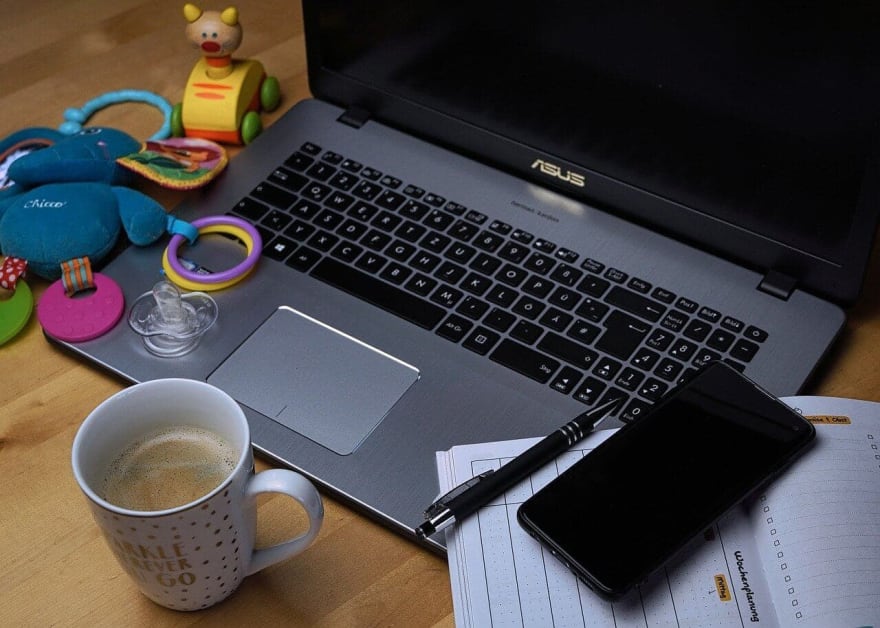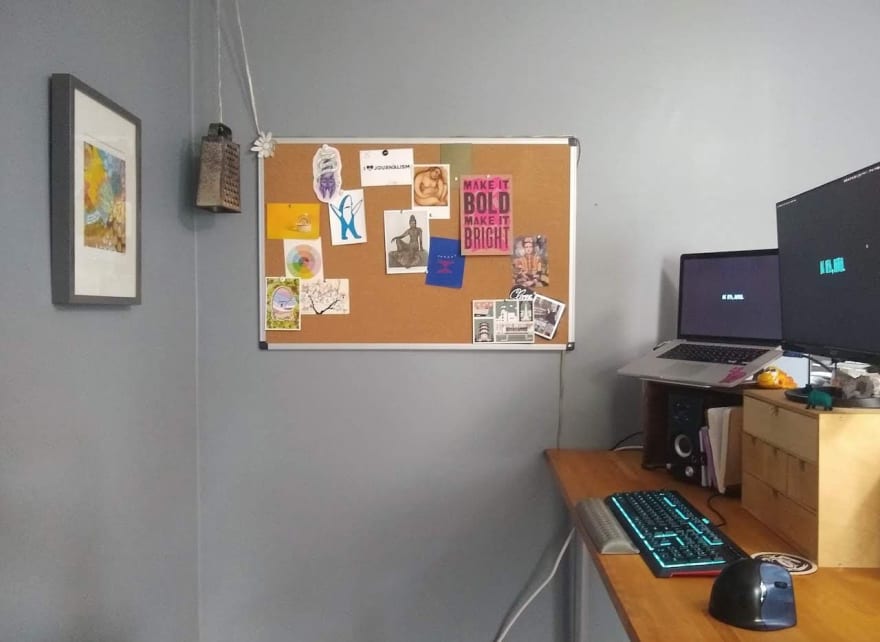To wrap up this series on remote work, I’m going to focus on the things that improve a remote worker’s life. In this article, I’ll share what has worked for me on an individual level and, in a later post, tackle what can be done and offered at the company/team level.
First, a reality check about what working remotely has looked like for me.
Pre-COVID, your social media streams may have been filled with images of folks with their laptops at airports, on beaches, in coffeeshops, in Airstream trailers. Remote work was seen as a means into a ✨ digital nomad ✨ lifestyle.
Since March 2020, the imagery used to describe remote work has changed a lot. The serenity and, let’s admit it, aspirational nature has been replaced mostly by chaos: partners working side-by-side on the couch, a kitchen table that is an office and a classroom, the WFH mullet.
Neither of these pictures represent my experience or ideal as a remote worker. When I’m showing up for work as a remote employee, that usually means I’m at my standing desk in my home office. Not only do I know where the nearest electrical outlet is, all my gear is plugged in and ready to go. I have speakers and headphones, external monitors and other peripherals. Being in a different location when I’m traveling, going to conferences or making an appearance at our headquarters, is novel, but it’s far from ideal for me.
Ben Halpern of Dev.to has written something about this as well:
I have been able to dramatically optimize for the 95% of the time I get to be sitting at the same desk with the same peripherals all hooked up. […] The 5% of the time I find myself away from this setup and still fully in work mode is a rather unideal scenario.
—Ben Halpern, The Best Remote Work is Delightfully Unglamorous
This isn’t to say I don’t unplug and roam at times (I’m writing this blog post from my couch with a snoring pitbull at my feet), but the vast majority of my work—both coding and interacting with my team—is done at my desk.
While we’re talking about my desk, let’s dive into some specifics about what keeps me happy as a remote worker:
Standing Desk === Dancing Desk
I started using a standing desk around 2011, in part inspired by Gina Trapani’s blog about their benefits. I find it’s pretty key to my happiness as a developer, keeping my mind engaged and my body flexible and moving. It’s easy for me to move about, including the not-infrequent dance break.
My set up is fairly simple: a wooden IKEA countertop and a set of telescoping legs. I’ve considered getting something fancier, but this has really worked for the last decade. 🤷🏻♀️
💡 You can read more about my desk and other details about my set up on my /uses page.
Consistency
While remote work is often lauded for its flexibility, what I appreciate is the flexibility to create a consistent schedule that works for me. The structure of my workdays is very consistent—including when I start and stop—while the content of those days and what the work itself looks like is quite changeable.
I start each workday by running a Ruby script that pulls data from my Google calendar and our team’s Jira board, presenting me with a list of scheduled events and tickets assigned to me. Reviewing this means I’m ready for meetings and can set reasonable expectations for myself about how much head’s-down time I’ll have for coding. I organize all this info in Markdown files, a hybrid system inspired by Coraline Ada’s lftm (low-friction task management) system and bullet journaling.
During the day, I check back in on this list, marking off things as they’re handled and adding notes about the tickets I’m working on. If I’m working solo, I usually have Focus@Will going in 20- or 35-minute intervals, which is like a supercharged Pomodoro.
I take regular breaks and make sure some of those, like lunch, are marked on my calendar and respected by my coworkers. Since a majority of my team is on the West coast, I also use their lunch break as an opportunity to get away from my desk and, weather permitting, enjoy some sunshine.
Finally, how I disconnect at the end of the day is just as important as the energy I bring to starting my workday. For this, I once again return to my daily agenda and review what I completed, noting what I’ll have to pick up tomorrow. Additionally, I’ve started to rely on the “5pm questions” from the free “Your Plucky Path” career planning guide created by Jen Dary. Revisiting why I’m working in the first place and acknowledging I’ve met those needs or goals is a great way to wrap up my workday.
Extroverts can do this, too
As a generally friendly and outgoing person, I often encountered some level of surprise that I am happier as a remote worker than in an office setting. Honestly, I think the key is that I usually have plenty social outlets, both in person and digital, with coworkers and with friends. Whatever interaction I’m missing out on at work, I’m instead able to gain in going to meetups or book club.
If work is your primary place of social engagement, I definitely understand how this might feel different. But, also: join a book club or schedule a movie night with friends!
It’s not always rosy
I used to say that in any month of working remotely, there’s always one garbage day, where the inconvenience of being in my house versus an office or coworking space was really obvious. Maybe my dog made a mess or the folks I share my house with have an unreasonable case of interruptitis. That day is irritating, but it’s not like that all the time, and the benefits definitely outweigh the frustrations.
Finally, it’s worth reiterating that these are the things that have made being remote work for me. These are my lessons and not hard-and-fast rules for anyone looking to be happy as a remote employee. A lot of articles about remote work are like that; full of DOs and DON’Ts, but not everyone needs the same things to be happy at work. Some folks, like me, need an office with a door, others are happy on the couch. What’s important is to know yourself well enough to establish those wants and the fine tune your work day for them.










Top comments (0)